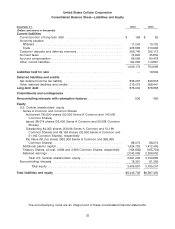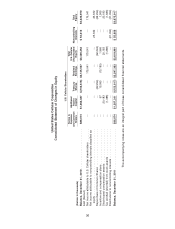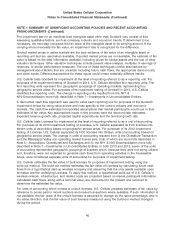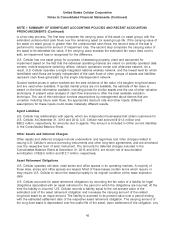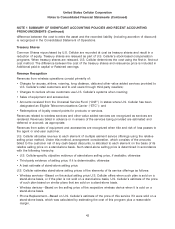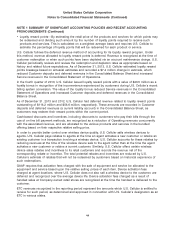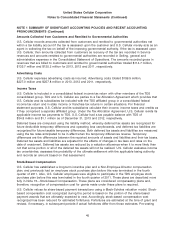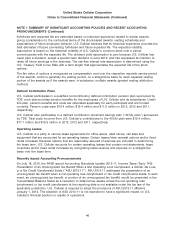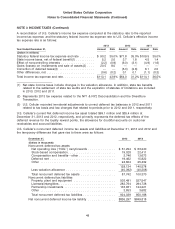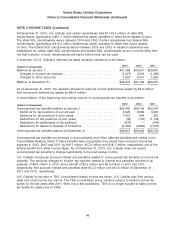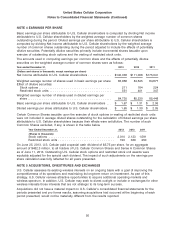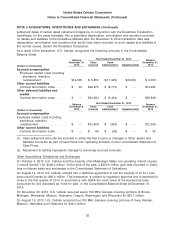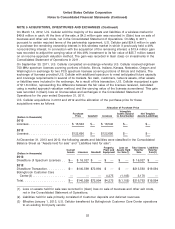US Cellular 2013 Annual Report Download - page 51
Download and view the complete annual report
Please find page 51 of the 2013 US Cellular annual report below. You can navigate through the pages in the report by either clicking on the pages listed below, or by using the keyword search tool below to find specific information within the annual report.United States Cellular Corporation
Notes to Consolidated Financial Statements (Continued)
NOTE 1 SUMMARY OF SIGNIFICANT ACCOUNTING POLICIES AND RECENT ACCOUNTING
PRONOUNCEMENTS (Continued)
difference between the cost to retire the asset and the recorded liability (including accretion of discount)
is recognized in the Consolidated Statement of Operations.
Treasury Shares
Common Shares repurchased by U.S. Cellular are recorded at cost as treasury shares and result in a
reduction of equity. Treasury shares are reissued as part of U.S. Cellular’s stock-based compensation
programs. When treasury shares are reissued, U.S. Cellular determines the cost using the first-in, first-out
cost method. The difference between the cost of the treasury shares and reissuance price is included in
Additional paid-in capital or Retained earnings.
Revenue Recognition
Revenues from wireless operations consist primarily of:
• Charges for access, airtime, roaming, long distance, data and other value added services provided to
U.S. Cellular’s retail customers and to end users through third-party resellers;
• Charges to carriers whose customers use U.S. Cellular’s systems when roaming;
• Sales of equipment and accessories;
• Amounts received from the Universal Service Fund (‘‘USF’’) in states where U.S. Cellular has been
designated an Eligible Telecommunications Carrier (‘‘ETC’’); and
• Redemptions of loyalty reward points for products or services.
Revenues related to wireless services and other value added services are recognized as services are
rendered. Revenues billed in advance or in arrears of the services being provided are estimated and
deferred or accrued, as appropriate.
Revenues from sales of equipment and accessories are recognized when title and risk of loss passes to
the agent or end-user customer.
U.S. Cellular allocates revenue to each element of multiple element service offerings using the relative
selling price method. Under this method, arrangement consideration, which consists of the amounts
billed to the customer net of any cash-based discounts, is allocated to each element on the basis of its
relative selling price on a stand-alone basis. Such stand-alone selling price is determined in accordance
with the following hierarchy:
• U.S. Cellular-specific objective evidence of stand-alone selling price, if available; otherwise
• Third-party evidence of selling price, if it is determinable; otherwise
• A best estimate of stand-alone selling price.
U.S. Cellular estimates stand-alone selling prices of the elements of its service offerings as follows:
• Wireless services—Based on the actual selling price U.S. Cellular offers when such plan is sold on a
stand-alone basis, or if the plan is not sold on a stand-alone basis, U.S. Cellular’s estimate of the price
of such plan based on similar plans that are sold on a stand-alone basis.
• Wireless devices—Based on the selling price of the respective wireless device when it is sold on a
stand-alone basis.
• Phone Replacement—Based on U.S. Cellular’s estimate of the price of this service if it were sold on a
stand-alone basis, which was calculated by estimating the cost of this program plus a reasonable
margin.
43


